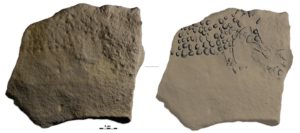
EPA head Scott Pruitt
Scott Pruitt, Donald Trump’s head of the US Environmental Protection Agency, has dismissed a basic scientific understanding of climate change by denying that carbon dioxide emissions are a primary cause of global warming.
Pruitt said on Thursday that he did not believe that the release of CO2, a heat-trapping gas, was pushing global temperatures upwards.
“I think that measuring with precision human activity on the climate is something very challenging to do and there’s tremendous disagreement about the degree of impact, so no, I would not agree that it’s a primary contributor to the global warming that we see,” he told CNBC. (emphasis added)
“But we don’t know that yet … We need to continue the debate and continue the review and the analysis.”
This stance puts Pruitt at odds with his own agency, which states on its website that carbon dioxide is the […]

At left, a limestone slab found at Abri Cellier in France that depicts a mammoth using what researchers say is a pointillist technique. At right, a drawing highlighting the shape made by the dots.
Credit R. Bourrillon
In 1884, Georges Seurat strategically placed dots atop a canvas, leading people to believe they were looking at an image of park-goers lounging along the Seine River in France. The technique was known as pointillism, and it seemed new at the time. But 38,000 years ago, people living inside caves in southwest France were doing something similar, according to findings published last month in Quaternary International.
“Their skills speak of a very high ability to observe in detail what surrounded them and reproduce it with great economy of means,” said Vhils, a Portuguese street artist who is known for his own chiseling of dots and lines into walls, and was not involved in the study.

A Neanderthal model on display at the Natural History Museum
Credit: The Natural History Museum, London
Despite their popular reputation as meat-eating simpletons, some Neanderthals ate a vegetarian diet and appear to have used natural forms of penicillin and aspirin to treat infections and pain.
Dental plaque was found on the fossilised teeth of Neanderthals who lived in what is now Asturias, Spain, and in Belgium up to 50,000 years ago.
In a startling demonstration of just how astonishing science can be, a team of researchers from Spain, Australia and the UK were able to extract DNA from the plaque that allowed them to tell what the individuals had eaten.
Neanderthals were thought to be enthusiastic meat eaters and an analysis of the remains found in Belgium revealed DNA from woolly rhinoceroses and wild sheep, along with a few mushrooms.
But the teeth of the Spanish group revealed they had eaten wild mushrooms, pine nuts and moss, but no evidence of meat, according to a paper in the journal Nature.
One of the researchers, Dr […]











